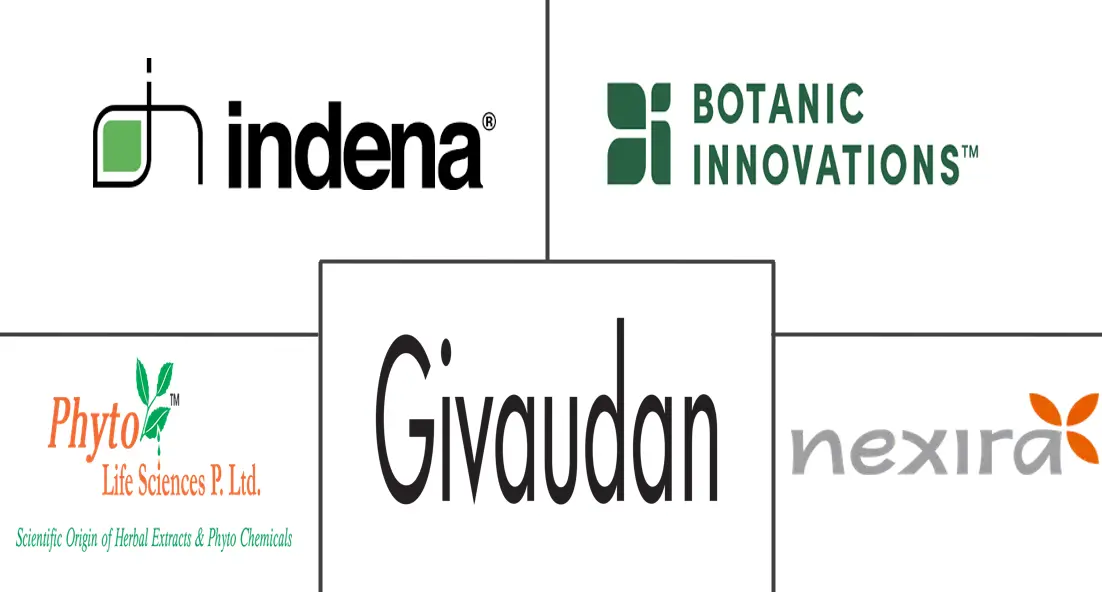Global Grapeseed Extract Market Size and Share
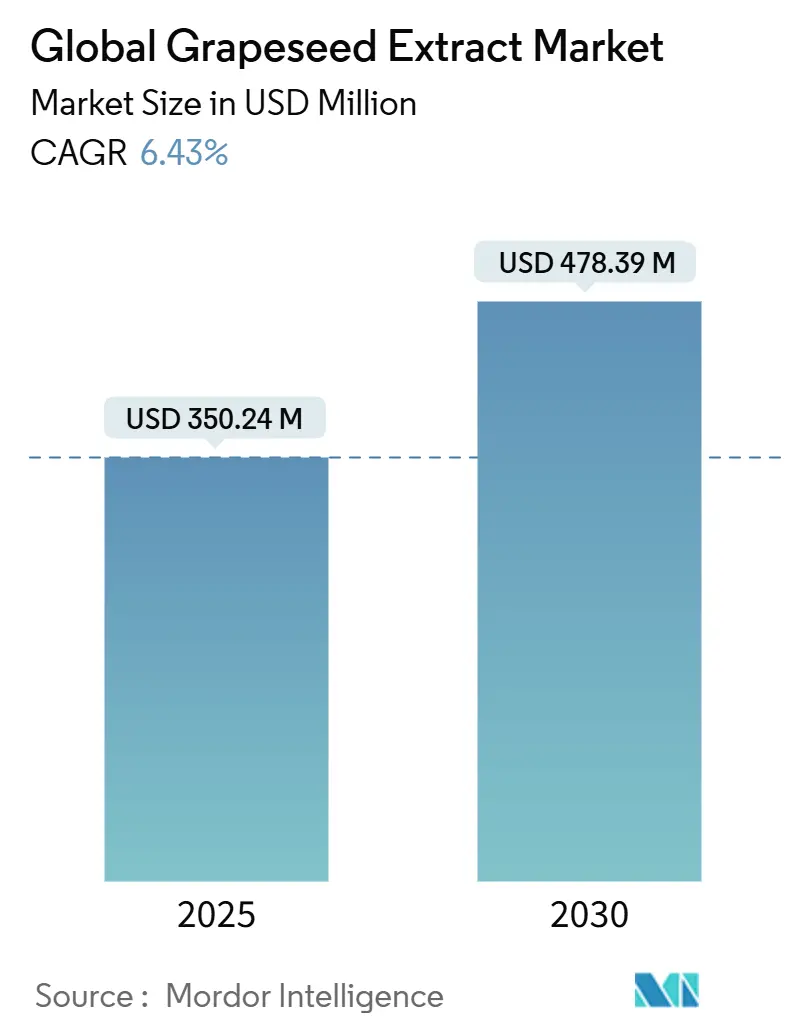
Global Grapeseed Extract Market Analysis by Mordor Intelligence
The global grape seed extract market was anticipated to reach USD 350.24 million in 2025 and is expected to reach USD 478.39 million by 2030, at a compound annual growth rate (CAGR) of 6.43% during the forecast period. The market growth is primarily attributed to increased consumer demand for natural health products, heightened awareness of preventive healthcare measures, and extensive applications across multiple industries. The expanding recognition of grape seed extract's cardiovascular health benefits has significantly influenced market expansion. Furthermore, the rising consumer preference for clean-label and plant-based products has strengthened market growth, particularly as consumers increasingly prioritize natural ingredients. The market is also experiencing substantial growth due to the extract's applications in the pharmaceutical industry, where it is utilized in various therapeutic formulations. Additionally, the cosmetics and personal care industry's incorporation of grape seed extract in anti-aging products and skin care formulations has contributed to market expansion.
Key Report Takeaways
• By form, powder held 55.29% of the grape seed extract market share in 2024; liquid is projected to expand at an 8.94% CAGR through 2030.
• By nature, conventional products led with 85.39% share in 2024; organic variants are forecast to advance at an 11.27% CAGR.
• By application, dietary supplements commanded 36.38% share of the grape seed extract market size in 2024, whereas pharmaceuticals are expected to grow at 9.83% CAGR to 2030.
• By geography, North America contributed 35.40% revenue in 2024, while Asia-Pacific is poised for a 9.77% CAGR over the forecast window.
Global Grapeseed Extract Market Trends and Insights
Drivers Impact Analysis
| Driver | (~) % Impact on CAGR Forecast | Geographic Relevance | Impact Timeline |
|---|---|---|---|
| Rising demand for natural antioxidants in dietary supplements | +1.2% | Global, with strongest growth in North America and Asia-Pacific | Medium term (2-4 years) |
| Expanding adoption in cosmetics and personal-care anti-ageing lines | +0.8% | Europe and North America core, expanding to Asia-Pacific premium segments | Medium term (2-4 years) |
| Premiumization trend in functional foods and beverages driving grape seed extract fortification | +0.6% | North America and Europe, emerging in urban Asia-Pacific markets | Long term (≥ 4 years) |
| Growing clinical evidence for cardiovascular benefits of grape seed extract | +0.9% | Global, with regulatory momentum in developed markets | Long term (≥ 4 years) |
| Regulatory approval of grape seed extract-based bio-fungicides in viticulture | +0.4% | Europe initially, potential expansion to global wine regions | Short term (≤ 2 years) |
| Adoption of cost-effective, eco-friendly sub-critical water extraction to meet clean-label demand | +0.5% | Global manufacturing hubs, led by Europe and North America | Medium term (2-4 years) |
| Source: Mordor Intelligence | |||
Rising demand for natural antioxidants in dietary supplements
The global grape seed extract market is experiencing growth driven by increasing demand for natural antioxidants in dietary supplements. Grape seed extract contains high levels of polyphenols, particularly proanthocyanidins, which provide antioxidant properties that combat oxidative stress, reduce inflammation, and support cardiovascular health. Consumer preference for preventive healthcare and clean-label nutrition has increased the demand for plant-derived ingredients like grape seed extract. The rising prevalence of lifestyle-related diseases, including heart disease, diabetes, and obesity, has enhanced the appeal of antioxidant-rich supplements. Grape seed extract has gained prominence due to its documented health benefits. The Council for Responsible Nutrition (CRN) reported that 74% of adults in the United States consumed dietary supplements in 2023, reflecting the widespread adoption of daily supplementation for proactive health maintenance [1]Council for Responsible Nutrition (CRN), "2023 CRN Consumer Survey on Dietary Supplements", www.crnusa.org. This trend supports the incorporation of grape seed extract in supplement formulations targeting heart health, immune function, and aging support.
Expanding adoption in cosmetics and personal-care anti-ageing lines
Grape seed extract demonstrates effectiveness in collagen synthesis and UV protection for cosmetic applications. Advanced encapsulation technologies, particularly hyalurosome formulations, improve dermal penetration and bioavailability, overcoming traditional limitations of topical polyphenol delivery. The incorporation of grape seed extract in premium anti-aging formulations aligns with industry trends toward natural, scientifically validated ingredients, as consumers seek products without synthetic additives. This trend drives the demand for anti-aging creams, evidenced by approximately 0.85 million men in Germany utilizing anti-aging cream within seven days in 2024, according to IfD Allensbach [2]Source: IfD Allensbach, "Number of men using anti-aging cream in Germany", www.ifd-allensbach.de. Recent patent developments, including formulations that combine grape seed extract with muscadine pomace and beta-glucan, show continued innovation in cosmeceutical applications for skin firmness, radiance, and tone improvement. The market growth continues as clinical studies validate grape seed extract's photoprotective properties and its effectiveness in enhancing keratinocyte viability under oxidative stress conditions.
Premiumization Trend in Functional Foods and Beverages
Food manufacturers systematically incorporate grape seed extract into functional beverages to address the requirements of health-conscious consumers seeking cardiovascular and cognitive benefits. The European Food Safety Authority's comprehensive assessment of grape pomace extracts, in conjunction with established safety protocols, facilitates regulatory compliance for functional food applications across principal markets. Advanced extraction methodologies, specifically supercritical CO2 and subcritical water techniques, enable the production of standardized extracts with optimal polyphenol concentrations while adhering to clean-label specifications. Market expansion continues as manufacturers develop precise formulations that maintain bioactive compound integrity and organoleptic characteristics across diverse food applications.
Growing clinical evidence for cardiovascular benefits of Grape Seed Extract
Clinical evidence supporting cardiovascular benefits drives the growth of the global grape seed extract market. Grape seed extract contains high concentrations of polyphenolic compounds, particularly oligomeric proanthocyanidins (OPCs), which have antioxidant and anti-inflammatory properties. Clinical studies show grape seed extract reduces blood pressure, improves endothelial function, decreases LDL cholesterol oxidation, and supports vascular health. These benefits address cardiovascular disease (CVD), the leading cause of death worldwide. As a result, grape seed extract has become an important ingredient in cardiovascular health supplements, particularly for aging populations and individuals with cardiovascular risk factors. The cardiovascular benefits are significant, considering the prevalence of heart disease. In 2023, the Centers for Disease Control and Prevention (CDC) reported that approximately 4.8% of adults in the United States had coronary heart disease (CHD). This clinical evidence establishes grape seed extract as a complement to conventional cardiovascular care, increasing its demand in nutraceutical and pharmaceutical applications.
Restraints Impact Analysis
| Restraint | (~) % Impact on CAGR Forecast | Geographic Relevance | Impact Timeline |
|---|---|---|---|
| Price volatility of raw materials due to grape harvest fluctuations and climate variability | -0.7% | Global, with acute impacts in California, Europe, Australia | Short term (≤ 2 years) |
| Divergent regional limits on proanthocyanidin daily intake | -0.4% | Primarily Europe vs North America regulatory differences | Medium term (2-4 years) |
| Quality-recall risk from residual solvents and heavy-metal loads | -0.6% | Global manufacturing centers, particularly emerging markets | Short term (≤ 2 years) |
| Intensifying competition from alternative polyphenol sources | -0.5% | Global, with strongest pressure in cost-sensitive segments | Long term (≥ 4 years) |
| Source: Mordor Intelligence | |||
Price volatility of raw materials due to grape harvest fluctuations and climate variability
Climate change affects grape production and supply chain stability. Grape cultivation areas are declining due to changing climate conditions. In Canada, the cultivation area decreased from 32,950 acres in 2022 to 31,000 acres in 2023, according to Canada Statistics [3]Source: Statistics Canada, "Area of grapes cultivated in Canada", www.statcan.gc.ca. Rising temperatures and altered precipitation patterns affect grape seed quality and proanthocyanidin concentrations, impacting extract yields and potency. This makes product standardization more challenging. Premium wineries often retain high-quality grape seeds for specialized applications rather than selling them to extract manufacturers, affecting the availability of wine industry by-products. Supply chain disruptions from extreme weather events demonstrate the industry's vulnerability to climate-related impacts. The increased demand for grape seed extract, especially organic and premium-grade materials, has created raw material price volatility, with these specialized products commanding higher prices than conventional alternatives.
Divergent regional limits on proanthocyanidin daily intake
The global regulatory landscape for grape seed extract remains fragmented. Health Canada mandates 100 mg daily limits and adult-only cautionary labeling, while European authorities apply different assessment criteria under novel food regulations. The European Food Safety Authority's restrictions on green tea extract containing EGCG, due to liver injury risks at 800 mg or higher daily doses, indicate heightened regulatory oversight that may affect grape seed extract products. Japan implements distinct health food regulations, requiring dedicated safety assessments and Food Sanitation Act compliance. These varying regulatory requirements across regions compel manufacturers to develop market-specific formulations and compliance protocols, resulting in increased development costs and market entry challenges.
Segment Analysis
By Form: Powder Dominance Drives Manufacturing Efficiency
Powder formulations lead the market with a 55.29% share in 2024. Manufacturers prefer powder formats due to their stability, standardization capabilities, and cost-effective processing for dietary supplement production. Powders offer better shelf stability and integrate easily into capsules and tablets, helping moisture-sensitive proanthocyanidins retain their potency during storage. Liquid formulations grow at 8.94% CAGR through 2030, as consumers prefer their better absorption rates and convenience in functional beverages and cosmetics. New encapsulation methods like liposomal and hyalurosome technologies improve how the body absorbs grape seed extract, supporting premium cosmeceutical products.
Manufacturers use sub-critical water extraction and supercritical CO2 processes to produce liquid extracts with high polyphenol content that meet clean-label standards at competitive costs. Pharmaceutical companies choose liquid forms for clinical use because they offer precise dosing and quick absorption for treatments. Private label manufacturers drive powder segment growth by seeking cost-effective standardized ingredients, though they face quality control and adulteration challenges that require better testing methods. While powders dominate sales volume, liquid forms generate higher profits through premium products and enhanced benefits.
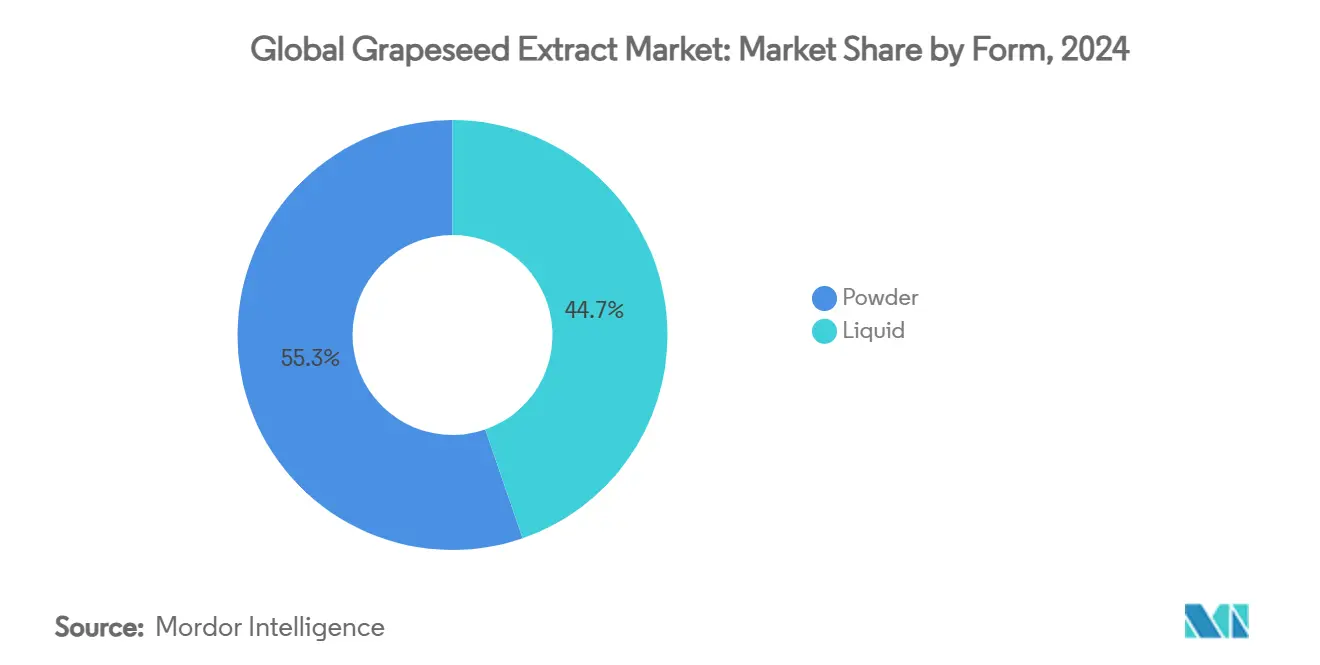
By Nature: Organic Premium Positioning Accelerates Market Differentiation
Conventional grape seed extract holds 85.39% market share in 2024, supported by established supply chains and cost advantages across dietary supplements and functional foods. This segment leverages mature extraction technologies and standardized processing methods to deliver consistent proanthocyanidin concentrations while maintaining competitive pricing. The organic segment is growing at 11.27% CAGR through 2030, driven by premium positioning and consumer acceptance of higher prices for certified organic ingredients. Organic certification requirements increase supply chain complexity but enable higher price premiums, especially in cosmetic and pharmaceutical applications where clean-label attributes enhance product differentiation.
The organic grape seed extract segment faces constraints from limited certified organic grape processing capacity and higher raw material costs. However, increasing consumer concerns about pesticide residues in conventional products support its growth. The expansion of organic variants aligns with clean-label trends in functional foods and dietary supplements, as manufacturers focus on sustainable sourcing and environmental responsibility. While conventional grape seed extract continues to dominate by volume, organic variants generate higher value through premium applications and positioning strategies that highlight sustainability and purity.
By Application: Pharmaceuticals Accelerate Beyond Traditional Supplements
Dietary supplements maintain the largest application share at 36.38% in 2024, driven by established consumer acceptance and regulatory pathways across multiple distribution channels. The supplements segment benefits from clinical validation of cardiovascular benefits, with trials showing significant reductions in carotid atherosclerotic plaque progression. Pharmaceuticals represent the fastest-growing segment at 9.83% CAGR, supported by increasing clinical evidence for therapeutic applications in cardiac remodeling and vascular health management. Food and beverage applications expand through functional product development, where grape seed extract enables premium positioning and health claims.
Cosmetics and personal care applications utilize grape seed extract's proven benefits in collagen synthesis and photoprotection, demonstrating improvements in skin hydration and wrinkle reduction through standardized treatment protocols. Animal nutrition applications show benefits in livestock health, including enhanced antioxidant capacity and gut microbial diversity in poultry production. Other applications, including industrial uses such as natural antimicrobial agents for water disinfection, present opportunities to expand beyond traditional health and nutrition markets.
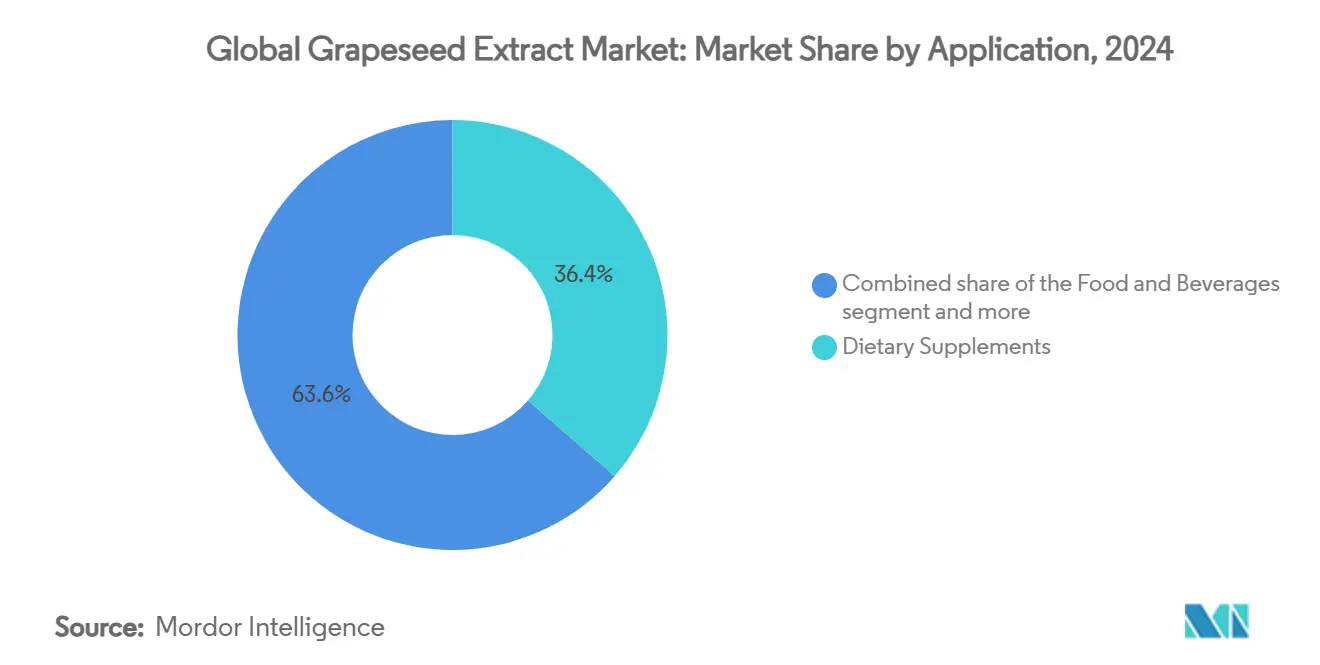
Note: Segment shares of all individual segments available upon report purchase
Geography Analysis
North America holds 35.40% market share in 2024, driven by mature dietary supplement markets, established regulatory frameworks, and consumer awareness of grape seed extract's health benefits. The region's leadership position results from widespread adoption of proanthocyanidin supplements and the Food and Drug Administration's GRAS status, enabling product development across multiple applications. California's grape production provides supply chain advantages, though climate change factors like extreme heat and wildfire risks affect raw material availability.
Europe shows substantial market potential following the European Commission's approval of grape seed extract as a basic substance for plant protection, expanding beyond dietary supplements. The region's focus on sustainable agriculture and reducing copper use in viticulture supports grape seed extract as a bio-fungicide. European Food Safety Authority assessments of grape pomace extracts and polyphenol health claims enable functional food applications, despite varying national regulations. The region's cosmetic sector demonstrates growth, with consumers accepting higher prices for natural, scientifically validated anti-aging ingredients.
Asia-Pacific exhibits the highest growth rate at 9.77% CAGR through 2030, attributed to increased health awareness, higher disposable incomes, and growing interest in preventive healthcare using natural antioxidants. Japan's regulatory structure for health foods and food additives provides clear market entry pathways, requiring thorough safety assessments and documentation. Chinese e-commerce giants elevate visibility through cross-border platforms, and functional drink startups blend grape seed extract with botanicals to appeal to young demographics. The region's growth continues as manufacturers develop products aligned with local regulations and preferences, incorporating traditional medicine and appropriate delivery formats.

Competitive Landscape
The grape seed extract market is fragmented, where key players use vertical integration and advanced extraction technologies to maintain their market position. Companies like Givaudan S.A., Indena S.p.A., Botanic Innovations, LLC, and Nexira target pharmaceutical-grade applications to maximize their returns on technology investments. These companies focus on quality assurance and regulatory compliance to address the widespread adulteration issues in commercial supplements. Companies actively develop patents for new extraction methods, including nanoparticle preparation technology that improves the absorption of water-insoluble compounds.
New companies enter the market with sustainable extraction technologies and specialty products, such as bio-fungicides and advanced cosmetic formulations. The pharmaceutical sector offers growth potential, especially in heart health management and recovery after heart attacks. Companies that invest in advanced extraction methods like supercritical and subcritical water processing gain advantages in meeting clean-label demands.
Extract manufacturers form partnerships with end-use industries to expand their market presence in functional foods and cosmetics. The market's lower-value segments remain fragmented, creating opportunities for business consolidation as quality and regulatory requirements become stricter across major markets. Companies with strong testing and authentication capabilities continue to gain market share as quality standards increase.
Global Grapeseed Extract Industry Leaders
-
Givaudan S.A.
-
Indena S.p.A.
-
Botanic Innovations, LLC
-
Phyto Life Sciences Private Limited
-
Nexira
- *Disclaimer: Major Players sorted in no particular order
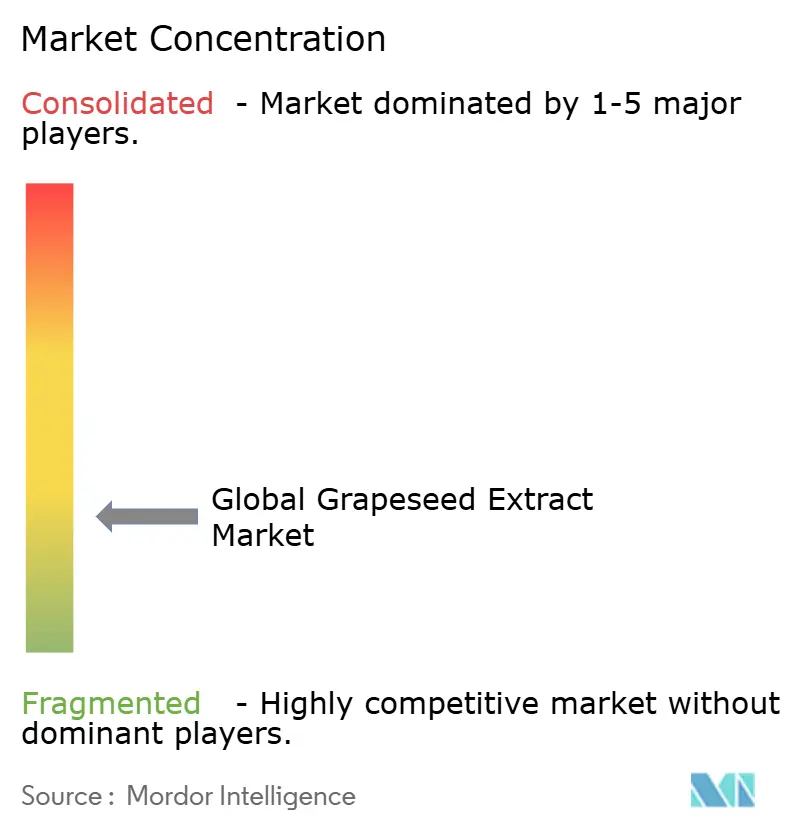


Recent Industry Developments
- July 2024: Nexira introduced two products: Okralin Fat Binder and VinOseed Grape Seed Extract. VinOseed SO free is a water-extracted grape seed extract without sulfites and contains high levels of OPC. The product's crystal form enables instant dissolution and carries Kosher certification.
- July 2024: Alvinesa Natural Ingredients acquired Chilean company Industrias Vínicas and Argentine company Dervinsa, establishing the group as one of the global leaders in grape seed oil, tartaric acid, and cream of tartar production.
- April 2024: Nordmann, a chemical distributor, announced the supply of a new water-soluble grape seed extract. The product contains high levels of oligomeric proanthocyanidins (OPC) and low levels of gallic acid and monomers. The extract is suitable for use in beverages, functional foods, and supplements.
Research Methodology Framework and Report Scope
Market Definitions and Key Coverage
Our study defines the grape seed extract market as the global value generated by standardized polyphenol-rich powders and liquids isolated from Vitis vinifera seeds through solvent or water extraction, sold for use in human food, dietary supplements, pharmaceuticals, cosmetics, and animal nutrition.
Scope Exclusion: Cold-pressed grape seed oil and wider polyphenol blends not expressly marketed as grape seed extract remain outside the present estimate.
Segmentation Overview
- By Form
- Liquid
- Powder
- By Nature
- Conventional
- Organic
- By Application
- Food and Beverages
- Cosmetics and Personal Care
- Pharmaceutical
- Dietary Supplements
- Animal Nutrition
- Others
- By Geography
- North America
- United States
- Canada
- Mexico
- Rest of North America
- Europe
- Germany
- United Kingdom
- Italy
- France
- Spain
- Rest of Europe
- Asia-Pacific
- China
- India
- Japan
- Australia
- Rest of Asia-Pacific
- South America
- Middle East and Africa
- North America
Detailed Research Methodology and Data Validation
Primary Research
Interviews and structured email surveys with ingredient manufacturers, contract extractors, nutraceutical formulators, and distribution partners across North America, Europe, and Asia-Pacific helped us validate utilization rates, emerging clean-label requirements, and ASP progression. Respondents also evaluated preliminary model outputs, closing remaining data gaps before final triangulation.
Desk Research
Mordor analysts first assembled foundational statistics from publicly available, tier-one sources such as the International Organization of Vine and Wine, FAOSTAT, Eurostat, and the United States Department of Agriculture to quantify grape crush volumes, regional by-product yields, and trade flows.
Regulatory lists from the European Food Safety Authority and U.S. FDA's GRAS database clarified approved dosage ranges, while scientific journals (Journal of Functional Foods, Phytotherapy Research) provided potency benchmarks.
Corporate 10-Ks, investor decks, and import-export filings shaped average selling price (ASP) bands by form.
Paid databases, notably D&B Hoovers for company revenues and Dow Jones Factiva for shipment news, supplied further cross-checks.
The sources cited here are illustrative, and many additional publications informed data collection, validation, and clarification.
Market-Sizing & Forecasting
A top-down reconstruction began with 2024 grape crush tonnage, by-product recovery ratios, typical extraction efficiencies, and polyphenol standardization losses. These volumes were converted to commercial kilograms and multiplied by form-specific ASPs.
Supplier roll-ups and sampled channel checks offered a bottom-up reasonableness test, after which totals were aligned.
Key variables in the model include nutraceutical penetration of adult populations, premium cosmetic launches featuring OPC claims, organic acreage growth, average dosage per finished product, and exchange-rate movements.
A multivariate regression patterned historical demand against wellness spending and grape supply cycles. Then ARIMA smoothing produced the 2025-2030 trajectory.
Gaps in bottom-up data were bridged using region-weighted ASP medians vetted during primary research.
Data Validation & Update Cycle
Outputs pass variance thresholds, peer analyst review, and anomaly screens before sign-off.
Reports refresh annually, with interim updates triggered by material regulatory or supply events. A fresh validation sweep precedes each client delivery.
Why Mordor's Grape Seed Extract Baseline Garners Confidence
Published figures often diverge because firms select different product scopes, price ladders, and refresh cadences, which are the main levers that move totals.
Key gap drivers in rival estimates include exclusion of functional feed volumes, inconsistent currency conversions, reliance on desk research without respondent verification, and straight-line historic extrapolation that ignores shifting wellness adoption curves.
Benchmark comparison
| Market Size | Anonymized source | Primary gap driver |
|---|---|---|
| USD 350.24 million (2025) | Mordor Intelligence | |
| USD 189.9 million (2024) | Global Consultancy A | Functional feed channel omitted; no primary validation |
| USD 177.8 million (2025) | Industry Association B | Only powder form counted; static ASP assumption |
| USD 180.5 million (2023) | Trade Journal C | Historic extrapolation, limited regional coverage |
Taken together, the comparison shows that Mordor Intelligence delivers a balanced baseline rooted in transparent variables, consistent scope choices, and yearly primary-source recalibration, giving decision-makers a dependable view for planning.


Key Questions Answered in the Report
What is the current value of the grape seed extract market?
The market is valued at USD 350.24 million in 2025 and is projected to reach USD 478.39 million by 2030.
Which region leads global demand?
North America holds 35.40% of revenue, driven by a mature nutraceutical sector and ready raw-material access.
Why are liquid grape seed extract formats growing faster than powders?
Liquids absorb more rapidly, blend easily into functional beverages and cosmetics, and benefit from clean-label extraction technologies, supporting an 8.94% CAGR.
How significant is organic grape seed extract?
Although conventional dominates in volume, organic variants are expanding at an 11.27% CAGR as consumers favor certified sustainable ingredients.
Page last updated on:
